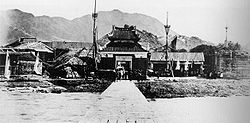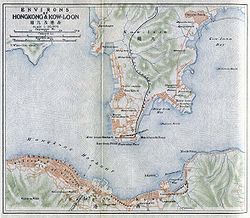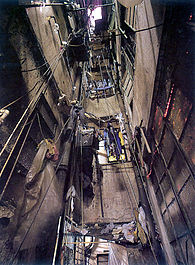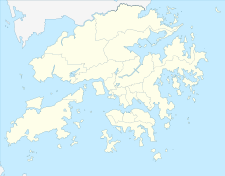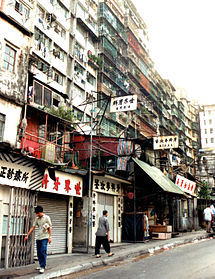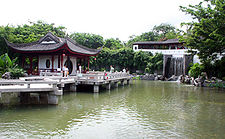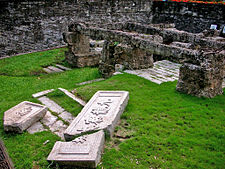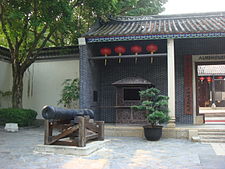- Kowloon Walled City
-
Kowloon Walled City 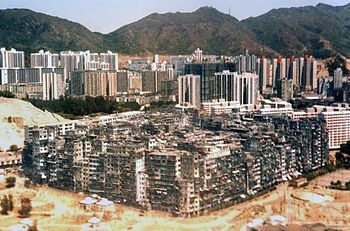
An aerial view of Kowloon Walled City in 1989 Traditional Chinese 九龍城寨 Simplified Chinese 九龙城寨 Transcriptions Mandarin - Hanyu Pinyin Jiǔlóng Chéng Zhài Cantonese (Yue) - Jyutping gau2 lung4 seng4 zaai6 Original name Traditional Chinese 九龍寨城 Simplified Chinese 九龙寨城 Transcriptions Mandarin - Hanyu Pinyin Jiǔlóng Zhài Chéng Cantonese (Yue) - Jyutping gau2 lung4 zaai6 seng4 Kowloon Walled City was a densely populated, largely ungoverned settlement in Kowloon, Hong Kong. Originally a Chinese military fort, the Walled City became an enclave after the New Territories were leased to Britain in 1898.
Its population increased dramatically following the Japanese occupation of Hong Kong during World War II. From the 1950s to the 1970s, it was controlled by Triads and had high rates of prostitution, gambling, and drug use. In 1987, the Walled City contained 33,000 residents within its 6.5-acre (0.03 km2; 0.01 sq mi) borders.
In January 1987, the Hong Kong government announced plans to demolish the Walled City. After an arduous eviction process, demolition began in March 1993 and was completed in April 1994. Kowloon Walled City Park opened in December 1995 and occupies the area of the former Walled City. Some historical artifacts from the Walled City, including its yamen building and remnants of its South Gate, have been preserved there.
Contents
History
Military outpost
The history of the Walled City can be traced back to the Song Dynasty (960–1279), when an outpost was set up to manage the trade of salt. Little took place for hundreds of years afterward, although 30 guards were stationed there in 1668.[1] A small coastal fort was established around 1810.[2] In 1842, during Qing Emperor Daoguang's reign, Hong Kong Island was ceded to Britain in accordance with the Treaty of Nanjing. As a result, the Qing authorities felt it necessary to improve the fort in order to rule the area and check further British influence. The improvements, including the formidable defensive wall, were completed in 1847. The Walled City was captured by rebels during the Taiping Rebellion in 1854 before being retaken a few weeks later.[1]
The Convention for the Extension of Hong Kong Territory of 1898 handed additional parts of Hong Kong (the New Territories) to Britain for 99 years, but excluded the Walled City, which at the time had a population of roughly 700. China was allowed to continue to keep officials there as long as they did not interfere with the defence of British Hong Kong. The following year, the Governor, Sir Henry Blake, suspected that the Viceroy of Canton was using troops to aid resistance to the new arrangements. On 16 May 1899, British forces attacked the Walled City, only to find the Viceroy's soldiers gone, leaving behind only the mandarin and 150 residents.[1]
Though the British claimed ownership of the Walled City, they did little with it over the following few decades. The Protestant church established an old people's home in the Yamen, as well as a school and almshouse in other former offices. Aside from such institutions, however, the Walled City became a mere curiosity for British colonials and tourists to visit. In 1933, the Hong Kong authorities announced plans to demolish most of the decaying Walled City's buildings, compensating the 436 squatters that lived there with new homes. By 1940 only the Yamen, the school, and one house remained. During its World War II occupation of Hong Kong, Japan demolished the City's wall and used the stone to extend the nearby Kai Tak Airport.[1]
Urban settlement
Here, prostitutes installed themselves on one side of the street, while a priest preached and handed out powdered milk to the poor on the other; social workers gave guidance, while drug addicts squatted under the stairs getting high; what were children's games centres by day became strip show venues by night. It was a very complex place, difficult to generalise about, a place that seemed frightening but where most people continued to lead normal lives. A place just like the rest of Hong Kong.
After Japan's surrender, China announced its intent to reclaim its rights to the Walled City. Refugees poured in to take advantage of Chinese protection, and 2,000 squatters occupied the Walled City by 1947. After a failed attempt to drive them out in 1948, the British adopted a 'hands-off' policy in most matters concerning the Walled City.[1]
With no government enforcement from the Chinese or the British save for a few raids by the Hong Kong Police, the Walled City became a haven for crime and drugs. It was only during a 1959 trial for a murder that occurred within the Walled City that the Hong Kong government was ruled to have jurisdiction there. By this time, however, the Walled City was virtually ruled by the organized crime syndicates known as Triads.[1]
Beginning in the 1950s, Triad groups such as the 14K and Sun Yee On gained a stranglehold on the Walled City's countless brothels, gambling parlors, and opium dens. The Walled City had become such a haven for criminals that police would venture into it only in large groups. It was not until 1973–74, when a series of more than 3,500 police raids resulted in over 2,500 arrests and over 4,000 pounds of seized drugs, that the Triads' power began to wane. With public support, particularly from younger residents, the continued raids gradually eroded drug use and violent crime. In 1983, the police commander of the Kowloon City District declared the Walled City's crime rate to be under control.[1]
The City also underwent massive construction during the 1960s and 1970s.[4] Eight municipal pipes provided water to the entire structure (although more could have come from wells).[5] A few of the streets were illuminated by fluorescent lights, as sunlight rarely reached the lower levels.[1] Although the rampant crime of earlier decades diminished in later years, the Walled City was still known for its high number of unlicensed doctors and dentists, who could operate there without threat of prosecution.[6]
Although the Walled City was for many years a hotbed of criminal activity, most residents were not involved in any crime and lived peacefully within its walls. Numerous small factories and businesses thrived inside the Walled City, and some residents formed groups to organize and improve daily life there. An attempt by the government in 1963 to demolish some shacks in a corner of the City gave rise to an "antidemolition committee" that served as the basis for a Kaifong association. Charities, religious societies, and other welfare groups were gradually introduced to the City. While medical clinics and schools went unregulated, the Hong Kong government did provide some services, such as water supply and mail delivery.[1]
Eviction and demolition
Over time, both the British and the Chinese governments found the City to be increasingly intolerable, despite the low reported crime rate.[citation needed] The quality of life in the City—sanitary conditions in particular—was far behind the rest of Hong Kong. The Sino-British Joint Declaration in 1984 laid the groundwork for the City's demolition.[1] The mutual decision to tear down the Walled City was announced on 14 January 1987.[7]
The government spent some HK$2.7 billion (US$350 million) in compensation to the estimated 33,000 residents and businesses in a plan devised by a special committee of the Hong Kong Housing Authority.[8] Some residents were not satisfied with the compensation, and were forcibly evicted between November 1991 and July 1992.[9][10] After four months of planning,[11] demolition of the Walled City began on 23 March 1993[6] and concluded in April 1994. Construction work on Kowloon Walled City Park started the following month.[12]
Layout and architecture
The Walled City was located in what became known as the Kowloon City area of Kowloon. In spite of its transformation from a fort into an urban enclave, the Walled City retained the same basic layout. The original fort was built on a slope[13] and consisted of a 6.5-acre (0.03 km2; 0.01 sq mi) plot measuring about 210 by 120 m (700 by 400 ft). The stone wall surrounding it had four entrances and measured 4 m (13 ft) tall and 4.6 m (15 ft) thick before it was dismantled in 1943.[2][14]
Construction surged dramatically during the 1960s and 1970s, until the formerly low-rise City consisted almost entirely of buildings with 10 stories or more (with the notable exception of the Yamen in its center).[4][7] However, due to the Kai Tak Airport's position 0.8 km (0.5 mi) south of the City, buildings did not exceed 14 stories.[15] The two-story Sai Tau Tsuen settlement bordered the Walled City to the south and west until it was cleared in 1985 and replaced with Carpenter Road Park.[16][17]
The City's dozens of alleyways were often only 1–2 m (3.3–6.6 ft) wide, and had poor lighting and drainage.[18] An informal network of staircases and passageways also formed on upper levels, which was so extensive that one could travel north to south through the entire City without ever touching solid ground.[4] Construction in the City went unregulated, and most of the roughly 350 buildings were built with poor foundations and few or no utilities.[19] Because apartments were so small—about 60% were 23 m2 (250 sq ft)—space was maximized with wider upper floors, caged balconies, and rooftop additions.[7][20][21] Roofs in the City were full of television antennas, clotheslines, water tanks, and garbage, and could be crossed using a series of ladders.[22][23]
Population
Kowloon Walled City's early population fluctuated between zero and a few hundred, and began growing steadily shortly after World War II. However, there is no accurate population information available for much of the Walled City's later existence. Official census numbers estimated the Walled City's population at 10,004 in 1971 and 14,617 in 1981, but these figures were commonly considered to be much too low. Informal estimates, on the other hand, often mistakenly included the neighboring squatter village of Sai Tau Tsuen.[18][24]
A thorough government survey in 1987 gave a clearer picture: an estimated 33,000 people resided within the Walled City.[7] Based on this survey, the Walled City had a population density of approximately 1,255,000/km2 (3,249,000/sq mi) in 1987. For comparison, Hong Kong as a whole (itself one of the most densely populated areas on earth) had a population density of about 6,700/km2 (17,000/sq mi) as of July 2009.[25]
Culture
Contrary to what many outsiders believed, most residents of the Walled City behaved similarly to other Hong Kongers. They were generally hardworking people who showed concern for living conditions, education and other pressing issues.[26] Residents also formed a tightly knit community, helping one another endure various hardships.[27]
Within families, wives often did housekeeping, while grandmothers cared for their grandchildren and other children from surrounding households.[28] The City's rooftops were an important gathering place, especially for residents who lived on upper floors. Parents used them to relax, and children would play or do homework there after school.[29]
The Yamen in the heart of the City was also a major social centre, a place for residents to talk, have tea or watch television, and to take classes such as calligraphy. The Old People's Centre also held religious meetings for Christians and others.[30] Other religious institutions included the Fuk Tak and Tin Hau temples, which were used for a combination of Buddhist, Taoist, and animist practices.[31]
Kowloon Walled City Park
The area where the Walled City once stood is now Kowloon Walled City Park (九龍寨城公園), located in today's Kowloon City District. The 31,000 m2 (330,000 sq ft) park was completed in August 1995, and opened officially a few months later on 22 December. Construction of the park cost a total of HK$76 million (US$9.8 million).[12] It is adjacent to Carpenter Road Park.[32]
The park's design is modeled on Jiangnan gardens of the early Qing Dynasty. It is divided into eight landscape features,[12] with the fully restored Yamen as its centrepiece. The park's paths and pavilions are named after streets and buildings in the Walled City.[33] Artifacts from the Walled City, such as five inscribed stones and three old wells, are also on display in the park.[32]
Components of the park include:
- The Eight Floral Walks, each named after a different plant or flower[34]
- The Chess Garden, featuring four 3 by 5 m (9.8 by 16 ft) Chinese chessboards[35]
- The Garden of Chinese Zodiac, containing stone statues of the 12 Chinese zodiac animals[36]
- The Garden of Four Seasons (named Guangyin Square after the small open area in the Walled City), a 300 m2 (3,200 sq ft) garden with plants that symbolize the four seasons[37]
- The Six Arts Terrace, a 600 m2 (6,500 sq ft) wedding area containing a garden and the Bamboo Pavilion[32]
- The Kuixing Pavilion, including a moon gate framed by two stone tablets and the towering Guibi Rock, which represents Hong Kong's return to China[38]
- The Mountain View Pavilion, a two-story structure resembling a docked boat that provides a good view of the entire park[32][39]
- The Lung Tsun, Yuk Tong, and Lung Nam Pavilions[40]
- The Yamen and the remains of the South Gate (see below).
Declared monuments
The Antiquities and Monuments Office conducted archaeological examinations as the Walled City was being demolished, and several cultural remains were discovered.[41] Among them were the Walled City's Yamen and remnants of its South Gate, which were officially designated as declared monuments of Hong Kong on 4 October 1996.[42]
The South Gate had originally served as the Walled City's main entrance. Along with its foundations, other remains included two stone plaques inscribed with "South Gate" and "Kowloon Walled City" from the South Gate and a flagstone path that had led up to it. The foundations of the City's wall and East Gate were also discovered.[12] The Hong Kong government preserved the South Gate remnants next to a square in front of the Yamen.[43]
The Yamen building is made up of three halls; originally the middle hall served as the Assistant Magistrate of Kowloon's administrative office, and the rear block was his residence. After the government officials left the area in 1899, it was used for several other purposes, including an old people's home, a refuge for widows and orphans, a school, and a clinic. It was restored in 1996 and is now found near the center of the park.[44] It contains a photo gallery of the Walled City, and two cannons dating back to 1802 sit at the sides of its entrance.[33]
Cultural depictions
The Walled City of Kowloon has no visible wall around it, but it is as clearly defined as if there were one made of hard, high steel. It is instantly sensed by the congested open market that runs along the street in front of the row of dark run-down flats—shacks haphazardly perched on top of one another giving the impression that at any moment the entire blighted complex will collapse under its own weight, leaving nothing but rubble where elevated rubble had stood.
A few people who spent time in Kowloon Walled City have written accounts of their experiences. Evangelist Jackie Pullinger wrote a 1989 memoir, Crack in the Wall, about her involvement in treating drug addicts within the Walled City.[46] In his 2004 autobiography Gweilo, Martin Booth describes his exploration of the Walled City as a child in the 1950s.[47] In addition to such accounts, many authors, game designers, and filmmakers have used the Walled City to convey a sense of oppressive urbanization or unfettered criminality.
In literature, Robert Ludlum's novel The Bourne Supremacy uses the Walled City as one of its settings.[45] The City appears as a virtual reality environment (described by Steven Poole as an "oasis of political and creative freedom") in William Gibson's Bridge trilogy, and as a contrast with Singapore in his Wired article "Disneyland with the Death Penalty".[48][49] In the manga Crying Freeman, the titular character's wife travels to the Walled City to master her swordsmanship and control a cursed sword.[50] The manga Blood+: Kowloon Nights uses the Walled City as the setting for a series of murders.[51]
The 1984 gangster film Long Arm of the Law features the Walled City as a refuge for gang members before they are gunned down by police.[47] In the 1988 film Bloodsport, starring Jean-Claude Van Damme, the Walled City is the setting for a martial arts tournament.[52] The 1992 non-narrative film Baraka features several highly detailed shots of the Walled City shortly before its demolition. The 1993 film Crime Story starring Jackie Chan was partly filmed in the deserted Walled City, and includes real scenes of building explosions.[53] A walled neighborhood called the Narrows in the 2005 film Batman Begins was inspired by the Walled City.[54] The 2006 Hong Kong horror film Re-cycle features a decrepit, nightmarish version of the Walled City, complete with tortured souls from which the protagonist must flee.[55] The anime series Street Fighter II V featured Kowloon Walled City as the location of an underground fighting circuit.
Hive of dream. Those mismatched, uncalculated windows. How they seemed to absorb all the frantic activity of Kai Tak airport, sucking in energy like a black hole.
Kowloon Walled City is also featured in several games, including Kowloon's Gate,[47] Shenmue II[56] and Call of Duty: Black Ops. Several missions in the Hitman series take place within it. The game Stranglehold, a sequel to the film Hard Boiled, features a version of the Walled City filled with hundreds of Triad members.[56] In the games Fear Effect and Fear Effect 2, photographs of the Walled City were used as inspiration "for moods, camera angles and lighting."[57] Concept art for the MMORPG Guild Wars: Factions depicts massive, densely-packed structures inspired by the Walled City.[58] The pen-and-paper RPG Shadowrun includes a crime-ridden, rebuilt version of the Walled City set in 2070.[59]
See also
- Lung Tsun Stone Bridge
- Chungking Mansions, a building in Hong Kong
- History of Hong Kong
- List of buildings and structures in Hong Kong
- List of urban public parks and gardens of Hong Kong
- Shibam, a densely populated city in Yemen of similar nature and construction
References
- General
- Lambot, Ian, ed (September 2007). City of Darkness: Life in Kowloon Walled City. Watermark. ISBN 978-1873200131.
- Specific
- ^ a b c d e f g h i j Wilkinson, Julia. "A Chinese Magistrate's Fort". In City of Darkness: Life in Kowloon Walled City. pp. 60–71.
- ^ a b Sinn, Elizabeth. "Kowloon Walled City: Its Origin and Early History". Journal of the Hong Kong Branch of the Royal Asiatic Society 27: 30–31. http://sunzi.lib.hku.hk/hkjo/view/44/4401608.pdf. Retrieved 25 November 2009.
- ^ Kwan, Leung Ping. "The Walled City: Our Place". In City of Darkness: Life in Kowloon Walled City. pp. 120–23.
- ^ a b c Lambot, p. 48.
- ^ Goddard, Charles (September 2007). "The Water Supply". In City of Darkness: Life in Kowloon Walled City. pp. 36–38.
- ^ a b Vines, Stephen (24 March 1993). "Demolition begins on HK's Walled City". Business Times. p. 4. http://www.lexisnexis.com:80/us/lnacademic/results/docview/docview.do?docLinkInd=true&risb=21_T7989989675&format=GNBFI&sort=RELEVANCE&startDocNo=1&resultsUrlKey=29_T7989989681&cisb=22_T7989989680&treeMax=true&treeWidth=0&csi=11432&docNo=1. Retrieved 25 November 2009. (subscription required)
- ^ a b c d Goddard, Charles. "The Clearance". In City of Darkness: Life in Kowloon Walled City. pp. 208–11.
- ^ Lau, Esme (10 December 1987). "$2.7 billion package for residents of Walled City". Hong Kong Standard. http://sunzi1.lib.hku.hk/newspaper/view/12_01.04/113867.pdf. (subscription required)
- ^ "Families evicted from slum city". Toronto Star. 28 November 1991. p. A3. http://www.lexisnexis.com:80/us/lnacademic/results/docview/docview.do?docLinkInd=true&risb=21_T7990092506&format=GNBFI&sort=BOOLEAN&startDocNo=26&resultsUrlKey=29_T7990080037&cisb=22_T7990092556&treeMax=true&treeWidth=0&csi=8286&docNo=26. Retrieved 25 November 2009. (subscription required)
- ^ Jonathan, Braude (3 July 1992). "Last squatters evicted in Kowloon". The Times. http://www.lexisnexis.com:80/us/lnacademic/results/docview/docview.do?docLinkInd=true&risb=21_T7990092506&format=GNBFI&sort=BOOLEAN&startDocNo=1&resultsUrlKey=29_T7990080037&cisb=22_T7990092556&treeMax=true&treeWidth=0&csi=10939&docNo=20. Retrieved 25 November 2009. (subscription required)
- ^ Kang-Chung, Ng (19 March 1993). "Work to start on slum area". South China Morning Post. p. 4. http://www.lexisnexis.com:80/us/lnacademic/results/docview/docview.do?docLinkInd=true&risb=21_T7990476798&format=GNBFI&sort=RELEVANCE&startDocNo=1&resultsUrlKey=29_T7990478301&cisb=22_T7990478300&treeMax=true&treeWidth=0&csi=11314&docNo=2. Retrieved 25 November 2009. (subscription required)
- ^ a b c d "Kowloon Walled City Park – History/Background". Leisure and Cultural Services Department. 21 October 2004. http://www.lcsd.gov.hk/parks/kwcp/en/index.php. Retrieved 6 November 2009.
- ^ Lambot, p. 18.
- ^ Benedetti, Paul (18 September 1982). "A nervy tour of Kowloon's Walled City". The Globe and Mail. http://www.lexisnexis.com:80/us/lnacademic/frame.do?reloadEntirePage=true&rand=1259611718806&returnToKey=20_T8029326180&parent=docview&target=results_DocumentContent&tokenKey=rsh-20.986244.6597036798. Retrieved 27 November 2009. (subscription required)
- ^ Lambot, p. 206.
- ^ Girard, Greg. "Foreword". In City of Darkness: Life in Kowloon Walled City. p. 7.
- ^ Lambot, p. 71.
- ^ a b Wesley-Smith, Peter (1998). Unequal treaty, 1898-1997: China, Great Britain, and Hong Kong's new territories (Rev. ed.). Hong Kong: Oxford University Press. pp. 189–90. ISBN 0195903544.
- ^ Lambot, pp. 48, 74, 79.
- ^ Lambot, pp. 34, 199.
- ^ Basler, Barbara (16 June 1992). "The Walled City, Home to Huddled Masses, Falls". The New York Times. p. A4. http://www.nytimes.com/1992/06/16/world/hong-kong-journal-the-walled-city-home-to-huddled-masses-falls.html. Retrieved 27 November 2009.
- ^ Popham, Peter. "Introduction". In City of Darkness: Life in Kowloon Walled City. pp. 9–13.
- ^ Lambot, pp. 199, 203.
- ^ Siu-Fong, Betty Ho (1986). Redevelopment of Kowloon Walled City: A Feasibility Study. University of Hong Kong. p. 52. OCLC 52017240.
- ^ "Hong Kong". The World Factbook. CIA. 28 October 2009. https://www.cia.gov/library/publications/the-world-factbook/geos/hk.html. Retrieved 28 October 2009.
- ^ Lambot, p. 90.
- ^ Lambot, p. 122.
- ^ Lambot, p. 115, 154.
- ^ Lambot, p. 203–04.
- ^ Lambot, p. 132.
- ^ Lambot, p. 26, 139.
- ^ a b c d "Location Database". Film Services Office. 1 June 2009. http://www.fso-createhk.gov.hk/lib/locations_details.cfm?Photo_Num=00011. Retrieved 18 November 2009.
- ^ a b "The Yamen". Leisure and Cultural Services Department. 21 October 2004. http://www.lcsd.gov.hk/parks/kwcp/en/yamen.php. Retrieved 17 November 2009.
- ^ "Eight Floral Walks". Leisure and Cultural Services Department. 21 October 2004. http://www.lcsd.gov.hk/parks/kwcp/en/eight.php. Retrieved 16 November 2009.
- ^ "The Chess Garden". Leisure and Cultural Services Department. 21 October 2004. http://www.lcsd.gov.hk/parks/kwcp/en/chess.php. Retrieved 16 November 2009.
- ^ "The Garden of Chinese Zodiac". Leisure and Cultural Services Department. 21 October 2004. http://www.lcsd.gov.hk/parks/kwcp/en/zodiac.php. Retrieved 16 November 2009.
- ^ "The Garden of Four Seasons". Leisure and Cultural Services Department. 21 October 2004. http://www.lcsd.gov.hk/parks/kwcp/en/four.php. Retrieved 16 November 2009.
- ^ "Kuixing Pavilion and Guibi Rock". Leisure and Cultural Services Department. 21 October 2004. http://www.lcsd.gov.hk/parks/kwcp/en/guibi.php. Retrieved 16 November 2009.
- ^ "The Mountain View Pavilion". Leisure and Cultural Services Department. 21 October 2004. http://www.lcsd.gov.hk/parks/kwcp/en/mountain.php. Retrieved 16 November 2009.
- ^ "Layout Plan". Leisure and Cultural Services Department. 21 October 2004. http://www.lcsd.gov.hk/parks/kwcp/en/layout.php. Retrieved 19 November 2009.
- ^ "The Geographical Information System on Hong Kong Heritage". Leisure and Cultural Services Department. http://www5.lcsd.gov.hk/gishinter/html/viewer_en.htm. Retrieved 19 November 2009.
- ^ "Annex I Listing of Declared Monuments". Environmental Protection Department. 28 April 2006. http://www.epd.gov.hk/epd/english/environmentinhk/eia_planning/sea/annex_i.html. Retrieved 6 November 2009.
- ^ "The Old South Gate". Leisure and Cultural Services Department. 21 October 2004. http://www.lcsd.gov.hk/parks/kwcp/en/gate.php. Retrieved 19 November 2009.
- ^ "Former Yamen Building of Kowloon Walled City, Kowloon Walled City Park". Leisure and Cultural Services Department. 5 February 2009. http://www.lcsd.gov.hk/ce/Museum/Monument/en/monuments_63.php. Retrieved 22 October 2009.
- ^ a b Ludlum, Robert (March 1987). The Bourne Supremacy. Bantam Books. ISBN 0-553-26322-6.
- ^ Pullinger, Jackie; Nick Danziger (1 May 1989). Crack in the Wall. Hodder & Stoughton Religious. ISBN 978-0340490679.
- ^ a b c McDonogh, Gary; Cindy Wong (30 August 2005). Global Hong Kong. Routledge. pp. 27–28. ISBN 978-0415947701.
- ^ Poole, Steven (3 May 2009). "Tomorrow's man". The Guardian. http://www.guardian.co.uk/books/2003/may/03/sciencefictionfantasyandhorror.williamgibson. Retrieved 15 October 2009.
- ^ a b Gibson, William (September/October 1993). "Disneyland with the Death Penalty". Wired (Condé Nast Publications) (1.04). http://www.wired.com/wired/archive/1.04/gibson_pr.html. Retrieved 16 November 2009.
- ^ Bartholow, Michael (4 October 2006). "Crying Freeman Volume 3 TPB". Advanced Media Network. http://anime.advancedmn.com/article.php?artid=3190. Retrieved 26 October 2009.
- ^ "Blood+: Kowloon Nights". Dark Horse Comics. http://www.darkhorse.com/Books/15-091/Blood-Kowloon-Nights. Retrieved 26 October 2009.
- ^ "New Age Timeout". New Age. 19 May 2005. http://www.newagebd.com/2005/may/19/time.html. Retrieved 21 October 2009.
- ^ Strother, Barbara. "Kowloon Walled City Park Information". Home & Abroad. http://www.homeandabroad.com/Hong-Kong/browse/attractions/Kowloon-Walled-City-Park/travel-tips. Retrieved 27 October 2009.
- ^ Otto, Jeff (6 June 2005). "Interview: Christopher Nolan". IGN. http://movies.ign.com/articles/622/622719p1.html. Retrieved 15 October 2009.
- ^ Shingleton, Matt (12 September 2006). "Re-Cycle". DVD Times. http://www.dvdtimes.co.uk/content.php?contentid=62753. Retrieved 17 October 2009.
- ^ a b McMillan, Fraser (7 September 2009). "Stranglehold". Thunderbolt. http://www.thunderboltgames.com/reviews/article/stranglehold-review-for-pc.html. Retrieved 24 October 2009.
- ^ Lui, Chi Kong (4 April 2001). "Interview with Stan Liu – Part 1". GameCritics. http://www.gamecritics.com/interview-stan-liu-part-1. Retrieved 24 October 2009.
- ^ "ArenaNet Art Director Daniel Dociu wins Spectrum 14 gold medal!". GuildWars.com. 9 March 2007. http://www.guildwars.com/events/press/interviews/20070309-danield.php. Retrieved 24 October 2009.
- ^ Boyle, Rob (17 July 2006). Shadowrun: Runner Havens. Fanpro. pp. 13, 26. ISBN 978-1932564686. http://www.scribd.com/doc/6707787/Runner-Havens. Retrieved 17 October 2009.
External links
Wikimedia Commons has media related to: - Kowloon Walled City
- Historical, architectural and political overview
- A team's exploration of the City before demolition
- Video clip of the City (Japanese)
- Cross-section image of the City
- Kowloon Walled City Park
- Official page with map at the LCSD website
- Photographs of the park
Coordinates: 22°19′56.21″N 114°11′25″E / 22.3322806°N 114.19028°E
Categories:- Forts in Hong Kong
- Declared monuments of Hong Kong
- Archaeological sites in Hong Kong
- Landmarks in Hong Kong
- Destroyed landmarks
- Kowloon City
- New Kowloon
- Urban public parks and gardens in Hong Kong
- Former populated places in China
- Former buildings and structures of Hong Kong
- Slums in Asia
- Enclaves
- Triad
- Disputed territories in Asia
- Territorial disputes of the United Kingdom
Wikimedia Foundation. 2010.

